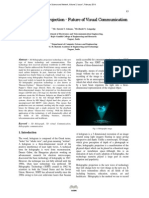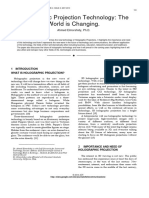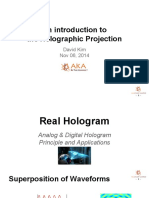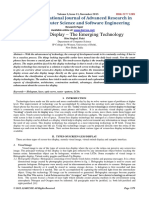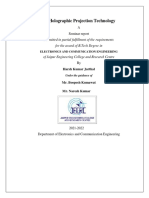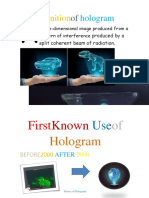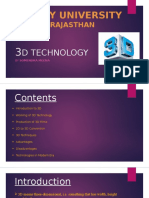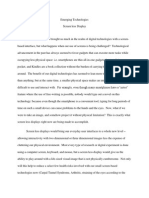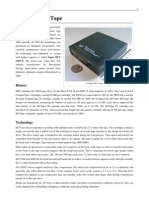Autostereoscopic Display
Technology is ever evolving. A new technology comes in a particular field one day; the next day,
we find it in the cold bag, substituted by a newer and better technology.
In the field of mobile displays, the above made statement stands as true as sunrise every
morning. When new technologies including AMOLED, Super AMOLED and Super AMOLED
Plus displays are incorporated in today’s smartphones, a unique autostereoscopic display has
been introduced in a few smartphones to bestow the users with glass-free 3D effect for still
images and videos.
Autostereoscopic Display is a technology that enables you to view stereoscopic (3D) images
without the help of head gears or glasses designed especially for the purpose. In simpler terms, it
is 3D viewing without any additional hassles. At the present moment high end smartphones like
HTC Evo 3D sports this feature as does the legendry gaming console called Nintendo 3D.
There are two different methods to lend 3D effects for the viewers- Parallax barrier and
Lenticular array.
In the parallax barrier technology, a second layer for LCD is placed above the main LCD display
that acts like a light barrier, blocking certain pixel from reaching a particular eye of the user. The
effect is precise only when the viewer’s face is located at a specific distance and angle from the
screen. The exact position where, the parallax barrier gives best 3D viewing results is known as
“sweet spot”. When the viewer moves away from the sweet spot, the wrong pixels get blocked,
resulting in failure in 3D perception.
In Lenticular display, an array of lenticular lens is placed on the LCD. It is designed in such a
way that different areas of screen are magnified and refracted in the direction of viewers’ eyes.
This technology allows 3D perception at various viewing angles, that means, multiple “sweet
spots’ are created along a horizontal viewing angle. Though HTC has not revealed the exact
technology involved in the autostereoscopic display of Evo 3D, the product enables viewing 3D
�images and videos from multiple “sweet spots”, so it could be using lenticular array to enable
stereoscopy.
The readers should note that the technology was pretty exorbitant in the past and continues to be
the same at the present time. But as they say, quality never comes cheap!
A holographic display
A holographic display is a type of display that utilizes light diffraction to create a virtual three-
dimensional image of an object. Holographic displays are distinguished from other forms of 3D
imaging in that they do not require the aid of any special glasses or external equipment for a
viewer to see the image.
Timeline
1947 - Hungarian scientist Dennis Gabor first came up with the concept of a hologram while
trying to improve the resolution of electron microscopes. He derived the name for holography,
with "holos" being the Greek word for "whole," and "gramma" which is the term for
"message."[1]
1960 - The world's first laser was developed by Russian scientists Nikolay Basov and Alexander
Prokhorov, and American scientist Charles H. Townes. This was a major milestone for
holography because laser technology serves as the basis of some modern day holographic
displays.[1]
1962 - Yuri Denisyuk invented the white-light reflection hologram which was the first hologram
that could be viewed under the light given off by an ordinary incandescent light bulb.[1]
1968 - White-light transmission holography was invented by Stephen Benton. This type of
holography was unique because it was able to reproduce the entire spectrum of colors by
separating the seven colors that create white light.[1]
1972 - Lloyd Cross produced the first traditional hologram by using white-light transmission
holography to recreate a moving 3-dimensional image.[1]
1989 - MIT spatial imaging group pioneered electroholography, which uses magnetic waves and
acoustic-optical sensors to portray moving pictures onto a display[1]
2005 - The University of Texas developed the laser plasma display, which is considered the first
real 3D holographic display.
2010 - Hollow pyramid shaped prisms are released into the consumer market, which if placed
over a flat screen (or smartphone), can emulate a three-dimensional image by means of 2-D light
refraction.[2]
2012 - The first holographic display is implemented in a car's interactive navigation display
system. The technology was showcased through the exclusive luxury car, the Lykan HyperSport.
�2013 - MIT researcher Michael Bove predicts that holographic displays will enter the mass
market within the next ten years, adding that we already have all the technology necessary for
holographic displays.[3]
Types of Holographic Displays
Laser Plasma
Laser plasma displays, developed in 2005 by the University of Texas, utilize a series of powerful
lasers that focus light in desired positions in order to create plasma excitations with the oxygen
and nitrogen molecules in the air. This type of holographic display is capable of producing
images in thin air, without the need for any sort of screen or external refraction media. The laser
plasma display is able to depict very bright and visible objects, but it lacks in terms of resolution
and picture quality.
Micromagnetic Piston Display
The piston display, invented by Belgian company IMEC in 2011, utilizes a MEMS (micro-
electro-mechanical system) based structure. In this type of display, thousands of microscopic
pistons are able to be manipulated up and down to act as pixels, which in turn reflect light with a
desired wavelength to represent an image. This developing technology is currently in the
prototype phase, as IMEC is still developing the mechanism that will mobilize their "pixels"
more effectively. Some of the limitations of this type of this display include the high cost,
difficulty of creating large screens, and its susceptibility to mechanical failures due to the
relatively large amount of moving parts (microscopic pistons).[4]
Holographic Television Display
The holographic television display was created by MIT researcher Michael Bove in 2013. Dr.
Bove used a Microsoft Kinect camera as a relatively effective way to capture subjects in a three-
dimensional space. The image is then processed by a PC graphics card and replicated with a
series of laser diodes. The produced image is fully 3-dimensional and can be viewed from all 360
degrees to gain spatial perspective. Bove claims that this technology will be widespread by 2023,
and that the technology will cost as much as today's ordinary consumer TV's.
Touchable Holograms[5][6]
Touchable holograms were originally a Japanese invention that became further developed by
American microprocessor company Intel. Touchable hologram technology is the closest modern
representation of the holographic displays that one might see in sci-fi movies such as Star Wars
and particularly in the Star Trek television franchise. This display is unique in that it can detect a
user's touch by sensing movements in the air. The device then provides haptic feedback to the
user by sending an ultrasonic air blast in return. In Intel's demonstration of this technology, the
display was showcased representing a touchless, responsive piano. A possible implementation
for this technology would be interactive displays in public kiosks; because this type of display
does not require a user to physically touch a screen, it ensures that bacteria and viruses do not get
transmitted from person to person.
Technologies Used
Laser
Most modern day holograms use a laser as its light source. In this type of hologram, a laser is
shone onto a scene that is then reflected onto a recording apparatus. In addition, part of the laser
�must shine directly onto a specific area of the display to act as a reference beam. The purpose of
the reference beam is to provide the recording device with information such as background light,
picture angle, and beam profile. The image is then processed to compensate for any variation in
picture fidelity, and then sent to the display.
Electroholography[7]
Electroholographic displays are digital displays that transmit stored image data using an
electromagnetic resonator. These signals are then read by an acoustic-optic modulator and
converted into a legible image and displayed on an RGB laser monitor. Electroholographic
displays hold an advantage over traditional displays in terms of picture accuracy and range of
color.
Full Parallax/HPO/VPO
Full parallax holography is the process of delivering optical information in both the x and y
directions. The resulting image will therefore provide the same perspective of a scene to all
viewers regardless of viewing angle.
Horizontal Parallax Only (HPO) and Vertical parallax Only (VPO) displays only deliver optical
information in two dimensions. This method of display partially compromises the image in
certain viewing angles, but it requires much less computational power and data transfer. Because
humans' eyes are positioned side by side, HPO displays are generally preferred over VPO
displays, and sometimes preferred over full parallax displays due to their lesser demand on
processing power.
MEMS
MEMS technology allows holographic displays to incorporate very small moving parts into its
design. The prime example of a MEMS-enabled display is the piston display, listed in the above
section. Micropistons used in the display can behave like pixels on a computer monitor, allowing
for sharp image quality.
Hologram-like Display
Mitsubishi is developing a hologram-like 'aerial display'.[8]
Multimedia
Multimedia is content that uses a combination of different content
forms such as text, audio, images, animations, video
and interactive content. Multimedia contrasts with media that use only
rudimentary computer displays such as text-only or traditional forms of
printed or hand-produced material.
Multimedia can be recorded and played, displayed, interacted with or
accessed by information content processing devices, such as
�computerized and electronic devices, but can also be part of a live
performance. Multimedia devices are electronic media devices used to
store and experience multimedia content. Multimedia is distinguished
from mixed media in fine art; for example, by including audio it has a
broader scope. In the early years of multimedia the term "rich media"
was synonymous with interactive multimedia, and "hypermedia" was an
application of multimedia.
data compression
Data compression is a reduction in the number of bits needed to
represent data. Compressing data can save storage capacity,
speed up file transfer, and decrease costs for storage hardware
and network bandwidth. Data compression enables sending a
data object or file quickly over a network or the Internet and in
optimizing physical storage resources. Data compression has
wide implementation in computing services and solutions,
specifically data communications. Data compression works
through several compressing techniques and software solutions
that utilize data compression algorithms to reduce the data size.
�Lossless compression
A lossless compression algorithm eliminates only redundant
information, so that one can recover the data exactly upon
decompression of the file.
Lossless data compression is compression without any loss of
data quality. The decompressed file is an exact replica of the
original one. Lossless compression is used when it is important
that the original and the decompressed data be identical. It is
done by re-writing the data in a more space efficient way,
removing all kinds of repetitions (compression ratio 2:1).
Some image file formats, notably PNG, use only lossless
compression, while those like TIFF may use either lossless or
lossy methods.
Lossy compression
A lossy compression method is one where compressing data and
then decompressing it retrieves data that may well be different
from the original, but is "close enough" to be useful in some
way.
The algorithm eliminates irrelevant information as well, and
permits only an approximate reconstruction of the original file.
Lossy compression is also done by re-writing the data in a more
space efficient way, but more than that: less important details of
the image are manipulated or even removed so that higher
compression rates are achieved. Lossy compression is
dangerously attractive because it can provide compression ratios
of 100:1 to 200:1, depending on the type of information being
compressed. But the cost is loss of data.
The advantage of lossy methods over lossless methods is that in
some cases a lossy method can produce a much smaller
�compressed file than any known lossless method, while still
meeting the requirements of the application.
JPEG
Stands for "Joint Photographic Experts Group." JPEG is a
popular image file format. It is commonly used by digital
cameras to store photos since it supports 224 or 16,777,216
colors. The format also supports varying levels of compression,
which makes it ideal for web graphics.
The 16 million possible colors in a JPEG image are produced by
using 8 bits for each color (red, green, and blue) in
the RGB color space. This provides 28 or 256 values for each of
the three colors, which combined allow for 256 x 256 x 256 or
16,777,216 colors. Three values of 0 produce pure black, while
three values of 255 create pure white.
The JPEG compression algorithm may reduce the file size of a
bitmap (BMP) image by ten times with almost no degradation in
quality. Still, the compression algorithm is lossy, meaning some
image quality is lost during the compression process. For this
reason, professional digital photographers often choose to
capture images in a raw format so they can edit their photos in
the highest quality possible. They typically export the pictures as
JPEG (.JPG) images when they are shared or published on the
web.
Besides image data, JPEG files may also include metadata that
describes the contents of the file. This includes the image
dimensions, color space, and color profile information, as well
as EXIF data. The EXIF data is often "stamped" on the image by
a digital camera and may include the aperture setting, shutter
speed, focal length, flash on/off, ISO number, and dozens of
other values.
�Disadvantages of the JPEG Format
While the JPEG format is great for storing digital photos, it does
have some drawbacks. For example, the lossy compression can
cause an issue called "artifacting," in which parts of the image
become noticeably blocky. This typically happens when a high
compression setting is used to save the image. For saving small
images and images with a lot of text, the GIF format is often a
better alternative. JPEG images also don't support transparency.
Therefore, the JPEG format is a poor choice for saving non-
rectangular images, especially if they will be published on
webpages with different background colors. The PNG format,
which supports transparent pixels is more ideal for these types of
images.









